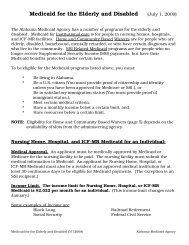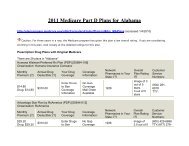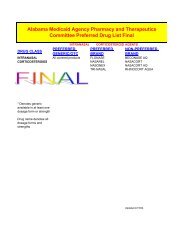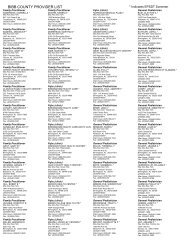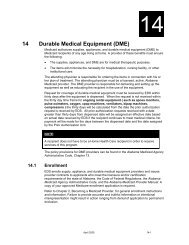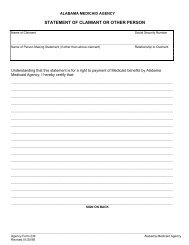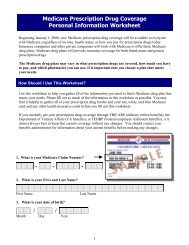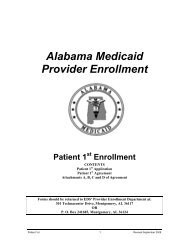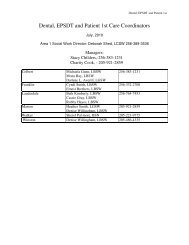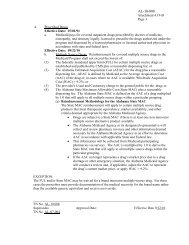PHARMACOTHERAPY REVIEW CNS STIMULANTS for treatment of ...
PHARMACOTHERAPY REVIEW CNS STIMULANTS for treatment of ...
PHARMACOTHERAPY REVIEW CNS STIMULANTS for treatment of ...
You also want an ePaper? Increase the reach of your titles
YUMPU automatically turns print PDFs into web optimized ePapers that Google loves.
Muscle toxicity is the most serious potential adverse effect. Muscle weakness, tenderness or painwith creatine kinase (CK) levels >10x the upper limit <strong>of</strong> normal is rare, occurring in approximately2 - 4 patients/1000 treated. Rhabdomyolysis may occur in 10 – 20 patients per 1,000,000 treated. 24Risk <strong>of</strong> myopathy increases in the presence <strong>of</strong> compromised renal function, the elderly, or in patientstaking drugs that interfere with statin metabolism. 19In 5 major trials and over 77,000 patient-years <strong>of</strong> statin exposure, 8 cases <strong>of</strong> myopathy werereported. 9-13 The MRC/BHF Heart Protection Study detected myopathy in 9 <strong>of</strong> 10,269 patientstreated with simvastatin <strong>for</strong> 5 years. 24 Risk <strong>of</strong> myopathy among currently marketed statins is verylow.Alternatives to statins are available if statins are not well tolerated or are contraindicated. Logicalalternatives are bile acid sequestrants (BAS) or a niacin <strong>for</strong>mulation to lower LDL. BASs lower LDL15% to 25%, are very safe, and have been shown to reduce CHD events (see LRC-CPPT study, Table5). The disadvantages <strong>of</strong> BASs are taste, consistency and their propensity to produce constipation,bloating, abdominal pain and gas. Colesevelam, a newer BAS, is available in tablet <strong>for</strong>m andproduces fewer side effects than powders and granules.Niacin is used more and more in lipid management and has been shown to reduce CHD events. 24 It isthe most effective agent <strong>for</strong> raising HDL and also effectively lowers triglycerides as well as LDL.Flushing and itching are bothersome side effects but can be minimized or avoided by premedication30 minutes be<strong>for</strong>e a niacin dose with 325 mg aspirin or 200 mg <strong>of</strong> ibupr<strong>of</strong>en. Up to 70% <strong>of</strong> patientstolerate niacin on a long-term basis. Extended-release niacin allows a once daily bedtime dose.Niacin-induced hepatotoxicity has occurred when doses exceed 1.5 g/day.Combination therapy involving niacin and/or a BAS, with or without a statin, may be indicated. Thecombination <strong>of</strong> niacin and a BAS can lower LDL as much as 50%. When a statin alone is not enoughto reach the LDL goal, a BAS, niacin, or both may be added to the statin regimen. When combined,the lower LDL achieved is generally the sum <strong>of</strong> the lowering provided by each drug (i.e., an additiveeffect). The addition <strong>of</strong> a BAS or niacin to statin therapy lowers LDL more than would a doubling <strong>of</strong>25, 26the statin dose. A triple drug regimen <strong>of</strong> lovastatin, niacin and colestipol produced a 60% LDLlowering. In this study, 83% <strong>of</strong> patients achieved their LDL goal <strong>of</strong> < 100 mg/dL. 27 Combinationtherapies should not be discounted. The additive effect can be significant and when combined, lipidlowering agents may be taken in lower, more tolerable and potentially safer doses.NON-HDL TREATMENT GOALSNon-HDL (i.e. total cholesterol minus HDL) <strong>treatment</strong> goals and guidelines are identified by NCEP-ATP III (see Table 2). Statins lower non-HDL as well as LDL. Thus, patients who have elevatedLDL and triglycerides (indicating increased levels <strong>of</strong> triglyceride-laden VLDL and IDL remnants)and high liver secretion <strong>of</strong> VLDL particles from the liver can benefit significantly from statin therapy.Statin non-HDL lowering parallels their LDL lowering capacity and appears to be dose-related. 28Statins are most effective when the non-HDL level is within 30 mg/dL <strong>of</strong> the goal. Non-HDL levelsabove this will probably require combination therapy with a statin and a triglyceride lowering drug(i.e., niacin, a fibrate, fish oils).Fibric acid lowering agents modestly increase LDL lowering <strong>of</strong> the statins, and the significanttriglyceride lowering effects <strong>of</strong> the fibric acid derivatives are modestly enhanced by the statins. Theincrease in HDL with the statin/fibric acid combination appear to be additive.6




